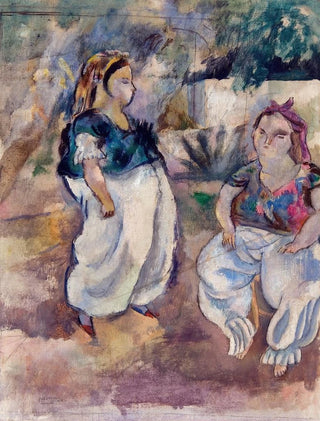Art print | The Tunisian Women - Jules Pascin


View from behind

Frame (optional)
In the world of art, some works manage to capture the essence of a culture and reproduce it with such intensity that they become iconic. "The Tunisian Women" by Jules Pascin is one of these creations. Painted in the early 20th century, this piece evokes not only the beauty of Tunisian women but also a historical moment when the Orient fascinated the West. Through this canvas, the artist transports us to a universe where vibrant colors and delicate forms blend to tell a story of exoticism and sensuality. Contemplating this art print, one feels the soul of a country, the warmth of its landscapes, and the richness of its traditions.
Style and uniqueness of the work
Jules Pascin's style is often characterized by a bold yet delicate approach. In "The Tunisian Women," he uses fluid brushstrokes and warm hues to evoke the Tunisian sunlight. The female figures, depicted with infinite grace, seem to dance across the canvas, embodying harmony between movement and tranquility. Pascin manages to capture not only the physical beauty of his subjects but also their spiritual essence. The faces are imbued with gentle melancholy, revealing an emotional depth that invites contemplation. This blend of lightness and gravity is what makes this art print so singular, allowing the viewer to engage in an intimate dialogue with the depicted characters.
The artist and his influence
Jules Pascin, born in Bulgaria and having spent much of his life in Paris, is an emblematic figure of the modernist movement. His artistic journey is marked by an unceasing quest for beauty and authenticity. Influenced by Impressionist and Fauvist currents, he develops a personal style that transcends the conventions of his time. Pascin is particularly interested in women, whom he depicts with rare tenderness and sensitivity. "The Tunisian Women" fits into this exploration of femininity, but it goes further by incorporating cultural elements that testify to the colonial era. The work illustrates how art can serve as a mirror to society, reflecting both

Matte finish

View from behind

Frame (optional)
In the world of art, some works manage to capture the essence of a culture and reproduce it with such intensity that they become iconic. "The Tunisian Women" by Jules Pascin is one of these creations. Painted in the early 20th century, this piece evokes not only the beauty of Tunisian women but also a historical moment when the Orient fascinated the West. Through this canvas, the artist transports us to a universe where vibrant colors and delicate forms blend to tell a story of exoticism and sensuality. Contemplating this art print, one feels the soul of a country, the warmth of its landscapes, and the richness of its traditions.
Style and uniqueness of the work
Jules Pascin's style is often characterized by a bold yet delicate approach. In "The Tunisian Women," he uses fluid brushstrokes and warm hues to evoke the Tunisian sunlight. The female figures, depicted with infinite grace, seem to dance across the canvas, embodying harmony between movement and tranquility. Pascin manages to capture not only the physical beauty of his subjects but also their spiritual essence. The faces are imbued with gentle melancholy, revealing an emotional depth that invites contemplation. This blend of lightness and gravity is what makes this art print so singular, allowing the viewer to engage in an intimate dialogue with the depicted characters.
The artist and his influence
Jules Pascin, born in Bulgaria and having spent much of his life in Paris, is an emblematic figure of the modernist movement. His artistic journey is marked by an unceasing quest for beauty and authenticity. Influenced by Impressionist and Fauvist currents, he develops a personal style that transcends the conventions of his time. Pascin is particularly interested in women, whom he depicts with rare tenderness and sensitivity. "The Tunisian Women" fits into this exploration of femininity, but it goes further by incorporating cultural elements that testify to the colonial era. The work illustrates how art can serve as a mirror to society, reflecting both






